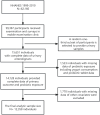Dietary probiotic ingestion is associated with elevated enterolignans concentration in the United States population, evidenced by NHANES 1999-2010
- PMID: 40386221
- PMCID: PMC12083011
- DOI: 10.3389/fnut.2025.1527029
Dietary probiotic ingestion is associated with elevated enterolignans concentration in the United States population, evidenced by NHANES 1999-2010
Abstract
Purpose: To investigate the associations between urinary enterolignans concentration and oral probiotic ingestion using nationally representative data from the United States population.
Methods: We analyzed dietary recall data and urinary enterolignans concentrations from 12,358 eligible participants in the National Health and Nutrition Examination Survey (NHANES) 1999-2010. Linear regression models with comprehensive covariate adjustments were employed to assess associations, accounting for demographic, socioeconomic, health status, and lifestyle factors.
Results: Participants with dietary probiotic ingestion had higher urinary concentrations of enterolignans, and probiotic ingestion showed robust and profound positive correlations with enterolignans after fully adjusted with multiple confounders (all p values<0.05). Frequent probiotic consumption exerts a more profound and positive impact on enterolignans concentrations than Infrequent probiotic consumption, according to correlation coefficient values in both univariate and multivariate analyses.
Conclusion: Dietary probiotic consumption was significantly associated with elevated urinary enterolignans concentrations in the U.S. population, with high-frequency intake demonstrating a stronger dose-response relationship compared to low-frequency consumption.
Keywords: NHANES (National Health and Nutrition Examination Survey); dietary; enterolignan; microbiota; probiotics.
Copyright © 2025 Dong, Huang, Wang, Luo, Wei, Abuduxukuer, Luo, Zhou and Peng.
Conflict of interest statement
The authors declare that the research was conducted in the absence of any commercial or financial relationships that could be construed as a potential conflict of interest.
Figures



References
LinkOut - more resources
Full Text Sources

